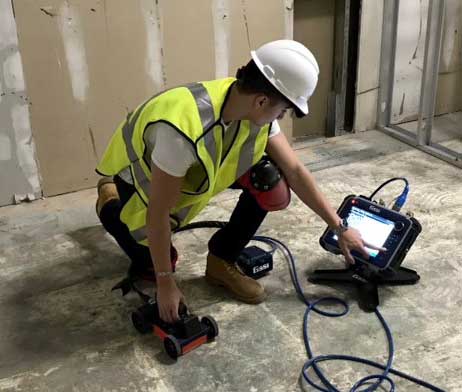Reveal the Transformative Power of Concrete Scanning in Taking Full Advantage Of Efficiency and Safety
Concrete scanning has emerged as a crucial device in the construction industry, supplying unequaled benefits in enhancing job effectiveness and making sure safety and security criteria. By utilizing advanced modern technology, concrete scanning permits specialists to see past the surface, revealing hidden complexities that can affect the architectural stability of a building. The transformative power of concrete scanning exists in its ability to supply real-time information and detailed understandings, transforming exactly how tasks are intended and implemented. As we explore the intricacies of this ingenious method, a globe of opportunities opens up, showcasing a new era of construction practices that focus on accuracy and protection.
Importance of Concrete Scanning
Guaranteeing the structural integrity and safety and security of construction projects starts with the vital step of conducting complete concrete scanning. Concrete scanning is a non-destructive approach used to detect and map subsurface aspects within concrete structures. This process is crucial in determining potential threats, such as rebar, post-tension cables, and avenues, that may be concealed within the concrete. By using advanced modern technologies like ground-penetrating radar (GPR) and electromagnetic induction, construction teams can properly situate these elements without creating any kind of damage to the framework.
Additionally, concrete scanning aids in optimizing job timelines and spending plan by avoiding unanticipated costs and delays that may occur due to unexpected obstructions within the concrete. Eventually, investing in complete concrete scanning is a positive technique that boosts both performance and safety and security in building and construction tasks.
Just How Concrete Scanning Works
Concrete scanning operates as a critical device in building projects by employing innovative modern technologies to find and map subsurface aspects without causing structural damages. Ground Permeating Radar (GPR) and Electromagnetic Induction (EMI) are two primary approaches made use of in concrete scanning. GPR works by releasing high-frequency radar pulses right into the surface, which jump back when they run into subsurface items or voids. The time considered the signal to return indicates the deepness and place of the objects. EMI, on the other hand, uses electro-magnetic areas to determine variances in material compositions, such as recognizing rebar or channels within concrete structures.
Throughout the scanning procedure, the information accumulated is examined in real-time, allowing instant identification of possible threats or barriers below the surface. By utilizing these sophisticated modern technologies, concrete scanning considerably lowers the risk of costly damages and injuries on building sites.
Advantages of Concrete Scanning
Utilizing advanced scanning technologies in building projects offers a wide range of advantages, enhancing both efficiency and safety on-site. Among the main benefits of concrete scanning is the capability to detect and situate embedded things such as rebar, post-tension wires, and avenues properly. By recognizing these components before boring or cutting right into concrete structures, the danger of accidental strikes is dramatically decreased, stopping possible injuries to employees and damage to the framework itself. Concrete scanning helps in preparation and developing more properly, as it provides accurate info concerning the place and deepness of architectural parts.

Study: Concrete Scanning Success

In another situation, a construction business made use of 3D concrete scanning to assess the problem old concrete structures in a historical structure. The comprehensive scans supplied important understandings into the level of degeneration and aided prioritize upkeep initiatives successfully. By proactively resolving areas of worry determined through scanning, the company was able to prolong the life-span of the structure and make sure passenger security.
These study underscore the transformative power of concrete scanning in enhancing efficiency, precision, and safety linked here and security in building and construction projects.
Executing Concrete Scanning in Projects
Executing sophisticated scanning modern technologies throughout construction projects has actually become increasingly vital for boosting accuracy and safety and security. By incorporating concrete scanning right into task preparation and click over here implementation, building and construction teams can recognize potential risks, such as rebar or post-tension cords, concealed within concrete frameworks. This aggressive technique lessens the danger of mishaps, delays, and costly rework, ultimately leading to much more efficient project timelines and spending plans.
To carry out concrete scanning successfully, job supervisors ought to collaborate closely with experienced scanning experts to establish one of the most appropriate scanning techniques for the specific job demands. Engaging scanning specialists from the early stages of a task allows the team to create thorough scanning plans that address vital locations of worry and guarantee complete data collection.
In addition, integrating concrete scanning into regular task process can streamline decision-making procedures, as real-time scan information provides prompt insights right into the condition of concrete frameworks - Concrete Scanning. This data-driven technique facilitates educated analytical and makes it possible for teams to make adjustments without delay, fostering a society of efficiency and security throughout the task lifecycle

Conclusion
In verdict, concrete scanning plays a vital duty in enhancing efficiency and security in building and construction jobs. By utilizing innovative innovation to map and spot out underlying frameworks within concrete, this process aids to prevent costly mistakes, make certain structural integrity, and lessen threats on website. With the capability to reveal covert aspects and give exact information, concrete scanning proves to be an important device for her comment is here maximizing project outcomes and maximizing total success.
Concrete scanning is a non-destructive technique utilized to spot and map subsurface aspects within concrete structures. In addition, concrete scanning assists in optimizing job timelines and spending plan by avoiding unforeseen expenses and hold-ups that might occur due to unpredicted blockages within the concrete. One notable case research entails a massive restoration job where concrete scanning played a crucial duty in making sure project success.In another case, a building and construction firm used 3D concrete scanning to evaluate the condition of maturing concrete structures in a historic structure. By incorporating concrete scanning into project preparation and execution, construction groups can recognize prospective risks, such as rebar or post-tension cables, concealed within concrete frameworks.